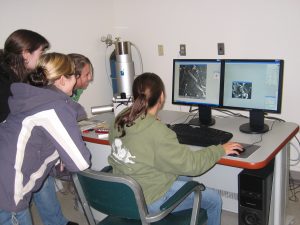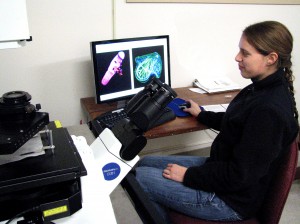Stockroom and chemicals:
The OIMB stockroom supplies glassware, common laboratory chemicals, and expendables such as slides and sample tubes, primarily for the use of classes. These supplies are limited, however, and chemical stocks consist primarily of leftovers from prior visitors, courses, or lab retirements. Therefore, visiting researchers should generally plan to bring or order their own reagents and other consumables. Visiting researchers should also feel welcome to contact the resident faculty, who are more than happy to help with modest needs. Ian Washington (iwashing@uoregon.edu) is the stockroom manager and can help visitors find what they need.
Microscopes:
SEM: The OIMB has a recent-model Tescan scanning electron microscope (installed 2008) along with a critical point dryer and and sputter coater. Interested researchers should contact Dr. Craig Young about use of the SEM.
Confocal: The OIMB has an Olympus FluoView 1000 laser-scanning confocal (installed 2009) with six illumination lines, filter-based detector, and SIM scanner (pending upgrade, 2013) on an inverted stand with cooling stages and micromanipulator. Interested researchers should contact Dr. Svetlana Maslakova about use of the confocal microscope.
Light microscopes and cameras: The Young, Emlet, and Maslakova labs have high quality compound microscopes equipped with DIC optics and various digital cameras, and the Maslakova lab has a Leica MZ10FL epifluoresence stereomicroscope with still and video cameras. Dr. Emlet has a Photron FastCam MC1 high-speed camera. Contact the cognizant faculty for use of these instruments.
In addition, a trinocular Leica stereomicroscope is available to visiting scientists; a second Leica trinoc stereo in the invertebrate teaching lab is available when not in use for class, as is an Olympus brightfield/darkfield compound with Point Grey Research color digital camera and computer to operate it. The teaching laboratories include numerous basic dissecting microscopes, fiber optic lights, and Leitz laborlux brightfield and phase compound microscopes which are available for research use when not needed by classes. Numerous analog video and still image cameras are kicking around somewhere; inquire locally. The stockroom has a large number of older dissecting microscopes (Wild, Bausch and Lomb, etc.) that can be used by visitors when the main teaching microscopes are in use by OIMB courses.
Other instruments and lab equipment:
ROV: Dr. Craig Young is the steward of OIMB’s 600-m Phantom ROV, which is described on its own page, along with the research vessels. This asset is available to visiting researchers and classes, but is only used under the guidance of a qualified operator.
Histology: The Young lab includes a complete laboratory for paraffin histology including embedding equipment and supplies, fume hood, microtomes, knife sharpeners, stains and accessories. Additional histology equipment is in the Visitors’ lab. There is a cryostat of unknown provenance; bring your own knife if you know what to do with it.
Centrifugation: OIMB has a Beckman L8-70M ultracentrifuge with SW50.1, SW28, SW40, and Ty65 rotors (needs recalibration; contact OIMB administration in advance if desired), a Beckman J2-HS superspeed centrifuge with JA-20 and JA14 rotors (in Emlet lab), and a Sorvall RC2-B with various rotors. Numerous microcentrifuges and low-speed clinical centrifuges are available in the stockroom or in faculty labs.
Molecular biology: Several of the faculty have PCR machines which may be available on request; there are several transilluminators on campus, and a digital gel imaging apparatus in the Maslakova lab; gel boxes and ancillary equipment are available in the stockroom or in faculty labs. The Maslakova lab has shaking incubators. Visiting researchers should expect to bring their own pipetvolk and other small equipment.
Specs and fluorometers: There are several common-use spectrophotometers, including a Beckman DU 640 (Research building) and Shimadzu BioSpec-mini (Visitors’ lab), Turner Designs 10-AU and 700 fluorometers (priority use by oceanography classes), and a Gentec spectrophotometer in the Young lab.
Microinjection: The Maslakova lab has microinjection equipment including micromanipulators on either inverted compound or stereomicroscope, picospritzer, needle puller, and microforge for making glass microtools. Please contact Dr. Maslakova or Dr. George von Dassow for use of these items. Some older micromanipulators are available in the Young lab.
Field and oceanographic equipment:
OIMB has numerous plankton nets of various sizes and mesh sizes, as well as beach seines, gill nets, and crab pots. A large Peterson grab can be deployed from the RV Pluteus, and a smaller grab is available for use from smaller boats. The pluteus may also be equipped with benthic dredges and otter trawls for sampling in the bay or the ocean.
A small CTD is available for sampling off ships. Contact the Shanks lab for information. The Young lab has several kinds of current meters (Falmouth Scientific Acoustic Doppler; older Anderraa meters, hand-held Marsh McBirney electromagnetic current probe) as well as acoustic releases, and sediment cores.
The stockroom houses a wide assortment of common field sampling equipment such as surveying tapes, a transit, numerous quadrats, rulers, clipboards, coolers, buckets, shovels, course sieves, etc. Complete sieve sets are available in the Young lab.
We have a dive locker with shower, some weights, lockers and 8 SCUBA tanks (fill at dive shop in town). However, as of early 2013 there is NO scientific diving through OIMB; contact Dr. Richard Emlet for updates.
Boring, but needful stuff:
Water: RO, glass-distilled, and Nanopure water are available in the Research building or Terwilliger building. The basement of the Terwilliger building also has an ice machine.
Cold storage and incubators: There are two shared ultracold freezers, one large capacity in the teaching labs and one in the Research building. There are currently NO common-use -20 freezers or refrigerators, except for household-type frost-free for routine reagent storage. A walk-in freezer in the Mud Room is available for large – ahem – specimens (i.e., whales or pieces thereof).
OIMB has three walk-in environmental chambers, two in the visitor lab and one in the Young lab. The latter is often available to visitors upon request . The units in the visitor lab are old and run only on request. If these are needed, please request them well in advance. There is an assortment of older-model incubators, some with light-cycle control.
Sterilization: There is a large-capacity steam sterilizer in the Research building, a small autoclave in the stockroom, and a top-loading autoclave and drying oven in the Maslakova lab. In addition, a high-capacity drying oven is available in the Mud Room.
Fume hoods: All faculty laboratories, the Visitors’ lab, and the invertebrate/McConnaughey teaching lab have conventional chemical fume hoods. The Emlet lab and the Visitors’ lab have laminar-flow hoods for dust-free or sterile work.
Miscellaneous:
Labconco freeze dryer; Muffle furnace; Balances (various, both in stockroom and faculty labs); Vacuum pumps; Ultrasonic baths; Light meters; something called a “stimulator”; Garlic presses and a salad spinner (no, really; they’re in the stockroom if you need ’em).
Workshop:
The maintenance shop is available to visitors after consultation with the maintenance crew, and includes a milling machine with a variety of tools. For small projects consult Dr. Alan Shanks.
Deep-Sea Culture Facilities:
The Young lab has titanium coil chillers that provide recirculating chilled seawater for four banks of large fiberglass tanks for holding deep-sea or cold-water animals. Additional chillers are also available. Numerous pressure vessels for culture of small deep-sea animals such as embryos are also available, including several with flow-through and transfer capability equipped with viewing ports and rated to full ocean depth.

